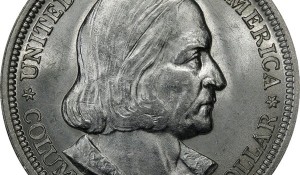Columbian Half Dollars Were the First U.S. Commemorative Coins
In 1892, the United States first minted Columbian Exposition silver half dollars to commemorate the 400th anniversary of Christopher Columbus’ voyage to the Americas. The Columbian half dollar was struck in 1892 and 1893 and was sold for $1 as a souvenir at the World’s Fair in Chicago. Over the course of two years, some 5 million pieces were struck, with 950,000 dated 1892 and the remainder made in 1893.
The Columbian half dollar was a collaborative effort of two famous coin designers – Charles E. Barber and George T. Morgan. Barber, whose popular work includes the Liberty nickel and “Barber” silver coinage, designed the obverse of the Columbian half dollar. George T. Morgan, whose most famous coin is the Morgan silver dollar, handled the art on the reverse of the Columbian half dollar.
While Columbian half dollars were popular with fairgoers, not all of these commemorative silver coins were sold. Only about half of the total number of pieces were either sold or released, and many wound up in circulation. In fact, a great many of these collectible souvenir coins entered the channels of commerce, and by 1900, Columbian half dollars were frequently found in pocket change. Few were carefully preserved by coin collectors.
Today, most of the surviving Columbian half dollars exhibit wear and age. Even those that were saved by coin collectors show signs of light handling, and many were cleaned – something that happened to scores of pre-20th century coins. However, by no means are Columbian half dollars rare, and most are found between the grades of Extremely Fine 40 and Mint State 60, and typical specimens cost between $15 and $30. Pristine uncirculated specimens are much rarer and can cost hundreds of dollars.
User comments
Thank you for pointing that out. Yes, technically the 1848 "CAL" eagle is the first commemorative for all intents and purposes, but given the fact that the 1892 Columbian Expo half dollar is commonly regarded as the first official commemorative (particularly as the first with a distinctive design/subject), that was the basis for choosing that piece here, which preceded the Isabella quarter, as you referenced, by one year.
Really, the traditional commemorative half dollars as a whole are a mixed lot, and there are many bargains out there for collectors, if by "bargain" one is to mean under $150. Certainly, several of those aforementioned 1918-39 commemorative halves qualify, especially those from the busy mid-1930s.
They're really great coins for many reasons, including design variation, mintages/surviving numbers, and overall value. It's surprising we don't see more activity in that sector today. Perhaps we will see growth in the traditional commemorative market again someday. When we do, choice circulated and uncirculated specimens are sure to be in demand.
Have a great day, sir!
Josh @ CoinValues
I have a few 1892 and 1893 PROOF coins (Columbus) in silver in nice grade, shiny.
If you are interested to see photos or advice me what';s a value of these coins please contact.
Radek
POLAND
EUROPE
-
{{#owner}}
-
{{#url}}
{{#avatarSrc}}
{{name}} {{/url}} {{^url}} {{#avatar}} {{& avatar}} {{/avatar}} {{name}} {{/url}} - {{/owner}} {{#created}}
- {{created}} {{/created}}

